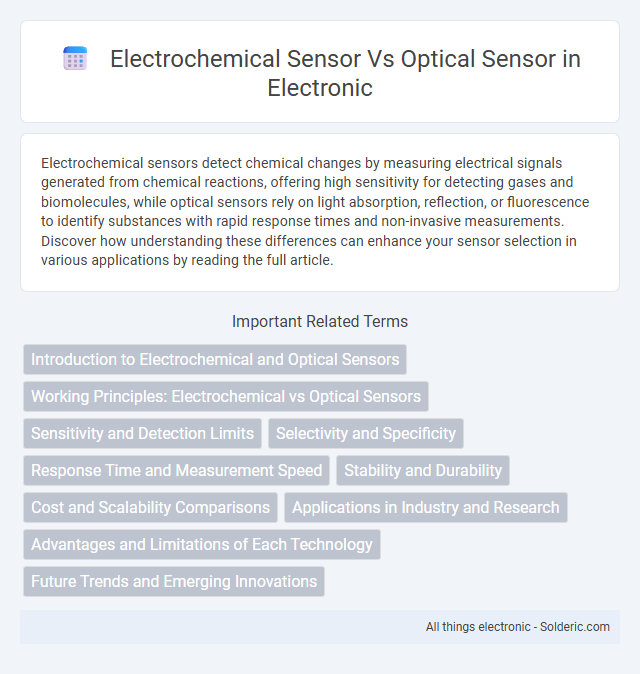Electrochemical sensors detect chemical changes by measuring electrical signals generated from chemical reactions, offering high sensitivity for detecting gases and biomolecules, while optical sensors rely on light absorption, reflection, or fluorescence to identify substances with rapid response times and non-invasive measurements. Discover how understanding these differences can enhance your sensor selection in various applications by reading the full article.
Comparison Table
| Feature | Electrochemical Sensor | Optical Sensor |
|---|---|---|
| Detection Principle | Measures electrical signals from chemical reactions | Detects changes in light properties (intensity, wavelength) |
| Sensitivity | High sensitivity to specific chemicals | High sensitivity with selective optical filters |
| Response Time | Typically fast (seconds to minutes) | Rapid (milliseconds to seconds) |
| Applications | Gas detection, biosensing, environmental monitoring | Environmental sensing, medical diagnostics, imaging |
| Interference | Prone to chemical interferences | Less affected by chemical noise, but affected by ambient light |
| Cost | Generally low to moderate | Moderate to high, depending on optical components |
| Durability | Moderate, sensitive to environmental conditions | High, less prone to degradation |
| Power Consumption | Low power | Moderate to high power |
Introduction to Electrochemical and Optical Sensors
Electrochemical sensors detect chemical substances by measuring electrical signals generated from redox reactions, offering high sensitivity for gases, ions, and biomolecules in environmental and medical applications. Optical sensors utilize light properties such as absorption, fluorescence, or refractive index changes to identify chemical or biological analytes, enabling non-invasive and remote sensing capabilities. Both sensor types provide critical real-time data for industrial monitoring, healthcare diagnostics, and environmental analysis, with performance optimized based on the analyte and detection environment.
Working Principles: Electrochemical vs Optical Sensors
Electrochemical sensors detect analytes by measuring electrical signals generated from redox reactions, often involving electrodes and changes in current or voltage. Optical sensors function by detecting changes in light properties such as absorption, fluorescence, or refractive index caused by interactions with the target substance. Your choice between electrochemical and optical sensors depends on the specific application's sensitivity, selectivity, and environmental conditions.
Sensitivity and Detection Limits
Electrochemical sensors exhibit high sensitivity and low detection limits due to their ability to directly measure electrical signals generated by chemical reactions, making them ideal for detecting trace amounts of analytes. Optical sensors, while highly sensitive to changes in light intensity or wavelength, often face higher detection limits compared to electrochemical sensors due to signal interference and environmental factors. Your choice between the two should consider the target application's sensitivity requirements and the specific detection limits achievable by each sensor type.
Selectivity and Specificity
Electrochemical sensors exhibit high selectivity and specificity through the use of selective electrodes and recognition elements that target specific analytes via redox reactions and ion exchange mechanisms. Optical sensors achieve specificity by employing selective light-absorption, fluorescence, or refractive index changes in response to particular molecules, often enhanced by molecular recognition elements like antibodies or aptamers. Compared to optical sensors, electrochemical sensors offer more pronounced signal changes for target analytes in complex matrices, while optical sensors provide label-free detection with high molecular specificity in real-time monitoring applications.
Response Time and Measurement Speed
Electrochemical sensors typically offer faster response times, often within seconds, due to direct electron transfer mechanisms enabling rapid detection of analytes. Optical sensors usually exhibit slightly slower measurement speeds, as they rely on light interaction and signal transduction processes that may require longer integration times. The swift responsiveness of electrochemical sensors makes them ideal for real-time monitoring applications demanding immediate feedback.
Stability and Durability
Electrochemical sensors offer high stability in detecting specific analytes due to their robust electrode materials and resistance to environmental interference, ensuring consistent performance over extended periods. Optical sensors, while highly sensitive and capable of real-time monitoring, may suffer from reduced durability when exposed to harsh environmental conditions such as UV radiation and moisture, leading to potential signal drift. The enhanced chemical stability of electrochemical sensors makes them preferable for long-term applications in industrial and environmental monitoring.
Cost and Scalability Comparisons
Electrochemical sensors generally offer lower manufacturing costs due to simpler materials and fabrication processes, making them highly scalable for mass production in industries like healthcare and environmental monitoring. Optical sensors, while providing superior sensitivity and selectivity, involve more expensive components such as lasers and photodetectors, leading to higher initial costs and more complex scaling challenges. The choice between these sensors depends on balancing budget constraints with application-specific performance requirements and production volume.
Applications in Industry and Research
Electrochemical sensors are widely used in industries such as environmental monitoring, food safety, and medical diagnostics due to their high sensitivity to specific chemical species and real-time detection capabilities. Optical sensors find extensive applications in research fields like biotechnology and chemical analysis, offering non-invasive, label-free monitoring of biological interactions and reactions through techniques like fluorescence and absorbance. Your choice between these sensor types depends on the required sensitivity, specificity, and operational environment in industrial or research settings.
Advantages and Limitations of Each Technology
Electrochemical sensors offer high sensitivity and selectivity for detecting specific analytes, with rapid response times and low power consumption, making them ideal for portable and in-field applications. Optical sensors provide non-contact measurement capabilities, enabling multiplexed detection and immunity to electromagnetic interference, but they often require more complex instrumentation and can be sensitive to environmental factors like light scattering and temperature variations. Limitations of electrochemical sensors include electrode fouling and limited lifespan, while optical sensors face challenges with calibration stability and higher initial costs.
Future Trends and Emerging Innovations
Future trends in electrochemical sensors emphasize enhanced sensitivity and miniaturization through nanomaterial integration, enabling real-time, point-of-care diagnostics. Optical sensors are advancing toward increased multiplexing capabilities and smartphone compatibility, leveraging plasmonic nanostructures and photonic crystals for improved detection limits. Your applications will benefit from hybrid sensor platforms combining electrochemical and optical techniques, expanding functionality in environmental monitoring and medical diagnostics.
electrochemical sensor vs optical sensor Infographic

 solderic.com
solderic.com